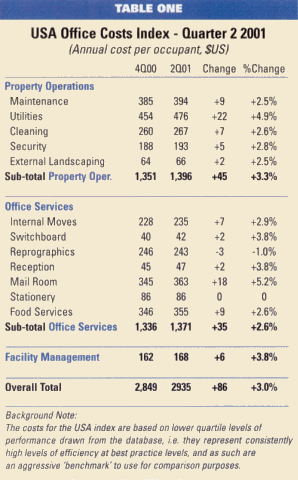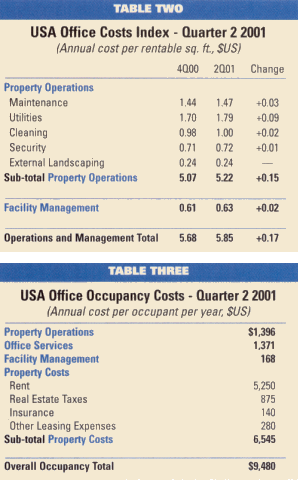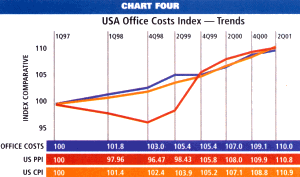Welcome to the 2nd Quarter 2001 Johnson Controls USA Office Occupancy Costs Index, which provides a snapshot guide to the cost of providing and operating property and facility management services in the USA. This cost index briefing is published twice a year and has become a powerful and dynamic business reference point for property and facility management professionals. Why Are These Indices Important? With property and facility management budgets often being squeezed and pressure increasing on managers to demonstrate greater effectiveness and provide more value, understanding how the costs of your operation are changing, and how they compare with others, is vital to identify particular areas of concern. The Johnson Controls USA Office Occupancy Costs Index gives you clear and concise benchmark costs for key property operations and office services activities. This can help as a broad guide and starting point to determine how your organization compares, and where cost levels may be changing through market pressures. We would stress, however, that the unique nature of facilities and individual service requirements means that any comparisons at this level should be undertaken with care. |
[See Tables One, Two, Three and Chart Four for data]

T |
The Johnson Controls USA Office Occupancy Costs Index is based on a detailed model of a medium grade air-conditioned office building, which operates reasonably efficiently with no unusually high service standards or demands. The building is 160,000 rentable sq. ft. (14,800 sq. m.) in size, and houses 600 occupants working between 8a.m. and 6p.m. five days a week. Figures reported reflect changes from the 4th Quarter 2000 (end December) to the 2nd Quarter 2001 (end June). It does not analyze changes in the cost of rents, local taxes, service charges, insurance, depreciation, small project works, IT and any capital investments/purchases, as variations in the level of these costs are too case-specific to monitor in this way. Notional sums for some of these property costs have been added in a separate analysis, however, to give a representation of the total occupancy cost for the model facility.
Costs have been measured in terms of the cost per occupant per year for all services (Table One), and in addition in terms of cost per rentable square feet (Table Two) for those services where a building’s area can be a significant cost driver. The cost-per-occupant measure is considered to be the more meaningful of the two from a business perspective, as for all services it is that which is most closely aligned to the primary purpose of the facility from the users perspective i.e. the productive support of people. Table Three shows, on a cost-per-occupant basis, a notional calculation of the total occupancy cost.

The Index (Table One) shows that, in overall terms, it now typically costs $2,935 each year to service an office-based employee at a place of work. In terms of the model facility with 600 occupants, this equates to a total annual cost of $1,761,000. Over the six-month period since the last index, this has increased by $52,000. Adding in the property costs gives a total occupancy cost (Table Three) of $9,480 per occupant, which equates to a total annual cost of $5,688,000 for the model facility.
Key Points To Note
(2nd Quarter 2001)
- Maintenance: Costs for labor and material have increased approximately 3 percent and 2 percent respectively over the six-month period.
- Energy & Water: Electricity costs have increased by 3.5 percent this period. Gas prices continue to climb reflecting a 26 percent increase. Since electricity is the most significant cost component, the weighted index was slightly less than 5 percent.
- Cleaning: Labor costs have increased by almost 3 percent during this six month period, while material increased by only 1/2 percent.
- Security: Cleaning labor costs have risen by slightly less than 3 percent.
- External Landscaping: Equipment costs have risen by about 0.5 percent following a decline in the previous period. Together with labor cost, the overall increase is approximately 2.5 percent.
- Internal Moves: Labor costs both for operative and management functions continue to rise, both increasing by just about 3 percent over the period. This rate of increase is greater than last period, where increases were slightly over 2 percent.
- Reprographics: Equipment and paper costs have both decreased resulting in a weighted decline of 1 percent.
- Mail Room: Recent increase in postage combined with 4 percent labor cost increase has resulted in an overall cost increase of 5 percent.
- Stationery: Paper prices have remained stable during this six-month period with no change in cost.
- Food Services: Labor and food costs have risen resulting in an increase of about 2.5 percent compared to prior periods’ increase of 1 percent.
- Facility Management: Labor costs for management have continued to rise at a rate of almost 4 percent, reflecting shortages in skilled and experienced personnel.
Trend
 Chart 4 shows how the Johnson Controls Office Costs Index has represented the changing level of underlying facility costs over the last 4 years. It shows how the rate of increase in office costs has fallen into line with those of producer prices and consumer prices. In particular, it is interesting to observe how producer prices have jumped over the last year. This could fuel inflation in facilities costs in the future as the effect of these are passed on to corporate buyers when contracts are renewed. Over the last two years, however, it would appear that the industry has found ways to improve productivity so that they are, at least for the most part, absorbed.
Chart 4 shows how the Johnson Controls Office Costs Index has represented the changing level of underlying facility costs over the last 4 years. It shows how the rate of increase in office costs has fallen into line with those of producer prices and consumer prices. In particular, it is interesting to observe how producer prices have jumped over the last year. This could fuel inflation in facilities costs in the future as the effect of these are passed on to corporate buyers when contracts are renewed. Over the last two years, however, it would appear that the industry has found ways to improve productivity so that they are, at least for the most part, absorbed.
How Can Johnson Controls Provide This Information?
Johnson Controls (JCI) is one of the largest facility management companies in the world. It operates in more than 500 locations in 40 countries and employs over 18,000 staff.
By building on this strength, JCI has developed International Performance Management (IPM), a process to measure accurately and compare the performance of facilities, not only from a cost perspective, but perhaps more significantly in terms of service efficiency and effectiveness. At the heart of IPM is a sophisticated web based knowledge database with information stored on thousands of buildings across the globe, occupying more than 500 million sq. ft. (46 million sq. m.). This database can be accessed and used by Johnson Controls managers and professionals around the world.
Information for the USA Indices is drawn from the IPM database.
